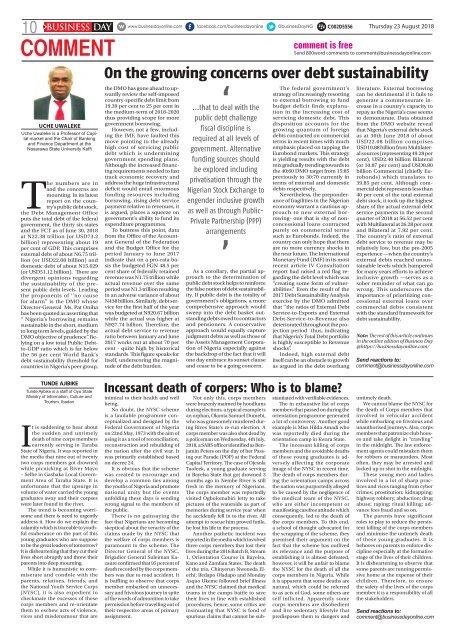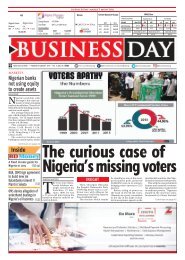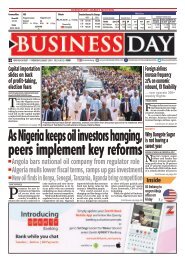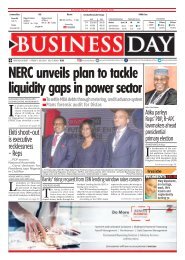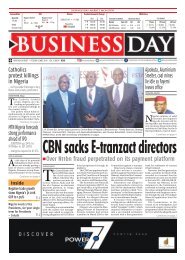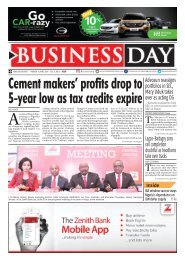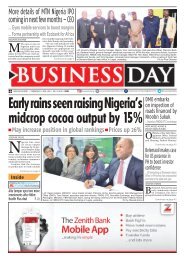BusinessDay 23 Aug 2018
You also want an ePaper? Increase the reach of your titles
YUMPU automatically turns print PDFs into web optimized ePapers that Google loves.
Thursday <strong>23</strong> <strong>Aug</strong>ust <strong>2018</strong><br />
10 BUSINESS DAY<br />
C002D5556<br />
COMMENT<br />
UCHE UWALEKE<br />
Uche Uwaleke is a Professor of Capital<br />
market and the Chair of Banking<br />
and Finance Department at the<br />
Nasarawa State University Keffi<br />
The numbers are in<br />
and the concerns are<br />
mounting. In its latest<br />
report on the country’s<br />
public debt stock,<br />
the Debt Management Office<br />
puts the total debt of the federal<br />
government, the thirty six states<br />
and the FCT as of June 30, <strong>2018</strong><br />
at N22.38 trillion (or USD73.2<br />
billion) representing about 19<br />
per cent of GDP. This comprises<br />
external debt of about N6.75 trillion<br />
(or USD22.08 billion) and<br />
domestic debt of about N15.629<br />
(or USD51.12 billion). There are<br />
divergent opinions regarding<br />
the sustainability of the present<br />
public debt levels. Leading<br />
the proponents of ‘’no cause<br />
for alarm’’ is the DMO whose<br />
Director-General Ms. Pat Oniha<br />
has been quoted as asserting that<br />
“ Nigeria’s borrowing remains<br />
sustainable in the short, medium<br />
to long term levels, guided by the<br />
DMO objective of prudence”. Relying<br />
on a low total Public Debtto-GDP<br />
ratio which is far below<br />
the 56 per cent World Bank’s<br />
debt sustainability threshold for<br />
countries in Nigeria’s peer group,<br />
comment is free<br />
Send 800word comments to comment@businessdayonline.com<br />
On the growing concerns over debt sustainability<br />
the DMO has gone ahead to upwardly<br />
review the self-imposed<br />
country-specific debt limit from<br />
19.39 per cent to 25 per cent in<br />
the medium-term of <strong>2018</strong>-2020<br />
thus providing scope for more<br />
government borrowing.<br />
However, not a few, including<br />
the IMF, have faulted this<br />
move pointing to the already<br />
high cost of servicing public<br />
debt which is undermining<br />
government spending plans.<br />
Although the increased financing<br />
requirements needed to fast<br />
track economic recovery and<br />
address the huge infrastructural<br />
deficit would entail enormous<br />
funding resources including<br />
borrowing, rising debt service<br />
payment relative to revenues, it<br />
is argued, places a squeeze on<br />
government’s ability to fund its<br />
expenditure programmes.<br />
To buttress this point, data<br />
from the Office of the Accountant<br />
General of the Federation<br />
and the Budget Office for the<br />
period January to June 2017<br />
indicate that on a pro-rata basis<br />
the budgeted FGN 48.5 per<br />
cent share of federally retained<br />
revenue was N1.75 trillion while<br />
actual revenue over the same<br />
period was N1.3 trillion resulting<br />
in an adverse variance of about<br />
N438 billion. Similarly, debt service<br />
for the first half of the year<br />
was budgeted at N920.67 billion<br />
while the actual was higher at<br />
N927.74 billion. Therefore, the<br />
actual debt service to revenue<br />
ratio between January and June<br />
2017 works out at about 70 per<br />
cent - quite high by historical<br />
standards. This figure speaks for<br />
itself, underscoring the magnitude<br />
of the debt burden.<br />
‘<br />
...that to deal with the<br />
public debt challenge<br />
fiscal discipline is<br />
required at all levels of<br />
government. Alternative<br />
funding sources should<br />
be explored including<br />
privatisation through the<br />
Nigerian Stock Exchange to<br />
engender inclusive growth<br />
as well as through Public-<br />
Private Partnership (PPP)<br />
arrangements<br />
’<br />
As a corollary, the partial approach<br />
to the determination of<br />
public debt stock helps to reinforce<br />
the false notion of debt sustainability.<br />
If public debt is the totality of<br />
government’s obligations, a more<br />
comprehensive approach would<br />
sweep into the debt basket outstanding<br />
debts owed to contractors<br />
and pensioners. A conservative<br />
approach would equally capture<br />
judgment debts as well as those of<br />
the Assets Management Corporation<br />
of Nigeria especially against<br />
the backdrop of the fact that it will<br />
one day embrace its sunset clause<br />
and cease to be a going concern.<br />
The federal government’s<br />
strategy of increasingly resorting<br />
to external borrowing to fund<br />
budget deficit finds explanation<br />
in the increasing cost of<br />
servicing domestic debt. This<br />
disposition accounts for the<br />
growing quantum of foreign<br />
debts contracted on commercial<br />
terms in recent times with much<br />
emphasis placed on tapping the<br />
Eurobond markets. This strategy<br />
is yielding results with the debt<br />
mix gradually trending towards to<br />
the 40:60 DMO target from 15:85<br />
previously to 30:70 currently in<br />
terms of external and domestic<br />
debts respectively.<br />
Nevertheless, the preponderance<br />
of fragilities in the Nigerian<br />
economy warrant a cautious approach<br />
to new external borrowing-<br />
one that is shy of nonconcessional<br />
loans contracted<br />
purely on commercial terms<br />
such as Eurobonds. Indeed, the<br />
country can only hope that there<br />
are no more currency shocks in<br />
the near future. The International<br />
Monetary Fund (IMF) in its most<br />
recent article IV Consultation<br />
report had raised a red flag regarding<br />
the debt level which was<br />
“creating some form of vulnerabilities.”<br />
Even the result of the<br />
2017 Debt Sustainability Analysis<br />
exercise by the DMO admitted<br />
that ‘’the ratios of External Debt<br />
Service-to-Exports and External<br />
Debt-Service-to-Revenue also<br />
deteriorated throughout the projection<br />
period thus, indicating<br />
that Nigeria’s Total Debt portfolio<br />
is highly susceptible to Revenue<br />
shocks’’.<br />
Indeed, high external debt<br />
itself can be an obstacle to growth<br />
as argued in the debt overhang<br />
literature. External borrowing<br />
can be detrimental if it fails to<br />
generate a commensurate increase<br />
in a country’s capacity to<br />
repay as the Nigeria’s case seems<br />
to demonstrate. Data obtained<br />
from the DMO website reveal<br />
that Nigeria’s external debt stock<br />
as at 30th June <strong>2018</strong> of about<br />
USD22.08 billion comprises<br />
USD10.88 billion from Multilateral<br />
sources (representing 49.28 per<br />
cent), USD2.40 billion Bilateral<br />
(or 10.87 per cent) and USD8.80<br />
billion Commercial (chiefly Eurobonds)<br />
which translates to<br />
39.85 per cent. Although commercial<br />
debt represents less than<br />
40 per cent of the total external<br />
debt stock, it took up the highest<br />
share of the actual external debt<br />
service payments in the second<br />
quarter of <strong>2018</strong> at 56.52 per cent<br />
with Multilateral at 26.28 per cent<br />
and Bilateral at 7.92 per cent.<br />
The country’s ratio of external<br />
debt service to revenue may be<br />
relatively low, but the pre-2005<br />
experience —when the country’s<br />
external debts reached unsustainable<br />
levels which hampered<br />
for many years efforts to achieve<br />
inclusive growth —serves as a<br />
sober reminder of what can go<br />
wrong. This underscores the<br />
importance of prioritizing concessional<br />
external loans over<br />
commercial debts consistent<br />
with the standard framework for<br />
debt sustainability.<br />
Note: The rest of this article continues<br />
in the online edition of Business Day<br />
@https://businessdayonline.com/<br />
Send reactions to:<br />
comment@businessdayonline.com<br />
TUNDE AJIBIKE<br />
Tunde Ajibike is a staff of Oyo State<br />
Ministry of Information, Culture and<br />
Tourism, Ibadan<br />
It is saddening to hear about<br />
the sudden and untimely<br />
death of nine corps members<br />
currently serving in Taraba<br />
State of Nigeria. It was reported in<br />
the media that nine out of twenty<br />
two corps members got drowned<br />
while picnicking at River Mayo<br />
– Selbe in Gashaka Local Government<br />
Area of Taraba State. It is<br />
unfortunate that the upsurge in<br />
volume of water carried the young<br />
graduates away and their corpses<br />
were later found in the river.<br />
The trend is becoming worrisome<br />
and there is need to urgently<br />
address it. How do we explain the<br />
calamity which is traceable to youthful<br />
exuberance on the part of this<br />
young graduates who are suppose<br />
to be the great leaders of tomorrow?<br />
It is disheartening that they cut their<br />
lives short abruptly and threw their<br />
parents into deep mourning.<br />
While it is humanistic to commiserate<br />
and condole with the<br />
parents, relations, friends, and<br />
the National Youth Service Corps<br />
(NYSC), it is also expedient to<br />
checkmate the excesses of these<br />
corps members and re-orientate<br />
them to eschew acts of violence,<br />
vices and misdenamour that are<br />
Incessant death of corpers: Who is to blame?<br />
inimical to their health and well<br />
being.<br />
No doubt, the NYSC scheme<br />
is a laudable programme conceptualized<br />
and designed by the<br />
Federal Government of Nigeria<br />
on 22nd May, 1973 with the aim of<br />
using it as a tool of reconciliation,<br />
reconstruction and rebuilding of<br />
the nation after the civil war. It<br />
was primarily established based<br />
on decree 24.<br />
It is obvious that the scheme<br />
was created to encourage and<br />
develop a common ties among<br />
the youths of Nigeria and promote<br />
national unity but the events<br />
unfolding these days is sending<br />
wrong signal to the members of<br />
the public.<br />
There is no gainsaying the<br />
fact that Nigerians are becoming<br />
skeptical about the veracity of the<br />
claims made by the NYSC that<br />
the welfare of corps members is<br />
paramount to the scheme. The<br />
Director General of the NYSC,<br />
Brigadier General Suleiman Kazaure<br />
confirmed that 95 percent of<br />
death recorded by the corps members<br />
was due to road accident. It<br />
is baffling to observe that corps<br />
member embarked on unnecessary<br />
and frivolous journey in spite<br />
of the words of admonition to take<br />
permission before travelling out of<br />
their respective areas of primary<br />
assignment.<br />
Not only this, corps members<br />
were brazenly maimed by hoodlums<br />
during elections, a typical example is<br />
an orphan, Okonta Samuel Dumebi,<br />
who was gruesomely murdered during<br />
Rives State’s re-run election. A<br />
corps member was also shot dead by<br />
a policeman on Wednesday, 4th July,<br />
<strong>2018</strong>, a SARS officer identified as Benjamin<br />
Peters on the day of her Passing<br />
out Parade (POP) at the Federal<br />
Capital Territory. The case of Ojesola<br />
Taofeek, a young graduate serving<br />
in Bayelsa State that got drowned 3<br />
months ago in Nembe River is still<br />
fresh in the memory of Nigerians.<br />
The corps member was reportedly<br />
visited Ogbolomabiri Jetty to take<br />
pictures of the waterside as part of<br />
memories during service year when<br />
he accidently fell in to the river. All<br />
attempt to rescue him proved futile,<br />
he lost his life in the process.<br />
Another pathetic incident was<br />
reported in the media which involved<br />
three corps members that lost their<br />
lives during the 2016 Batch B, Stream<br />
1, Orientation Course in Bayelsa,<br />
Kano and Zamfara States. The death<br />
of the trio, Chinyerun Nweneda Elechi;<br />
Ifedapo Oladapo and Monday<br />
Asquo Ukeme followed brief illness<br />
and the NYSC claimed that medical<br />
teams in the camps battle to save<br />
their lives in line with established<br />
procedures, hence, some critics are<br />
insinuating that NYSC is fond of<br />
spurious claims that cannot be sub-<br />
stantiated with verifiable evidences.<br />
The in exhaustive list of corps<br />
members that passed on during the<br />
orientation programme generated<br />
a lot of controversy. Another good<br />
example is Miss Hilda Amadi who<br />
was reportedly died during the<br />
orientation camp in Kwara State.<br />
The incessant killing of corps<br />
members and the avoidable deaths<br />
of these young graduates is adversely<br />
affecting the corporate<br />
image of the NYSC in recent time.<br />
The death of corps members during<br />
the orientation camps across<br />
the nation was purportedly alleged<br />
to be caused by the negligence of<br />
the medical team of the NYSC,<br />
who are either incompetent or<br />
manifesting carefree attitude which<br />
consequently, led to the death of<br />
the corps members. To this end,<br />
a school of thought advocated for<br />
the scrapping of the scheme, they<br />
premised their argument on the<br />
fact that the scheme has outlived<br />
its relevance and the purpose of<br />
establishing it is almost defeated,<br />
however, it will be unfair to blame<br />
the NYSC for the death of all the<br />
corps members in Nigeria. While<br />
it is apparent that some deaths are<br />
natural, which could be referred<br />
to as acts of God, some others are<br />
self inflicted. Apparently some<br />
corps members are disobedient<br />
and live sedentary lifestyle that<br />
predisposes them to dangers and<br />
untimely death.<br />
We cannot blame the NYSC for<br />
the death of Corps members that<br />
involved in vehicular accident<br />
while embarking on frivolous and<br />
unauthorised journeys. Also, corps<br />
members that patronize club houses<br />
and take delight in “crawling”<br />
in the midnight. The law enforcement<br />
agents could mistaken them<br />
for robbers or maraunders. Most<br />
often, they may be arrested and<br />
locked up or shot in the midnight.<br />
These young men and ladies<br />
involved in a lot of sharp practices<br />
and vices ranging from cyber<br />
crimes; prostitution; kidnapping;<br />
highway robbery; abduction; drug<br />
abuse; raping; ritual killing; advance<br />
fees fraud and so on.<br />
The parents have significant<br />
roles to play to reduce the persistent<br />
killing of the corps members<br />
and minimise the untimely death<br />
of these young graduates. It is<br />
behoves on parents to enforce discipline<br />
especially at the formative<br />
stage of the lives of their children.<br />
It is disheartening to observe that<br />
some parents are running permissive<br />
home at the expense of their<br />
children. Therefore, to ensure<br />
the safety of the lives of the corps<br />
member it is a responsibility of all<br />
the stakeholders.<br />
Send reactions to:<br />
comment@businessdayonline.com


